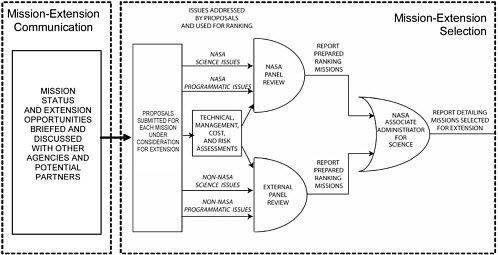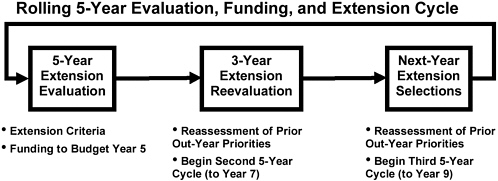4
Adapting the Senior Review Process to Earth Science Missions
With the NASA Senior Review process established as a solid foundation for making mission-extension decisions in general, the remaining task is to determine how this process can be applied or modified to meet the particular needs of Earth science missions. As noted previously, these additional needs arise largely from the potential for operational utility inherent in Earth science missions and the importance of both interagency and international partnerships as a result.
The committee found that the Senior Review process needs to be modified in two fundamental areas in order to meet the needs of Earth science. First, a comprehensive, formal mechanism is needed for alerting other agencies and partners to mission-extension opportunities. Second, the process needs to be adapted so as to solicit and consider the requirements of such agencies and partners as well as those of NASA. Three specific enhancements to the Senior Review are suggested to accomplish these adaptations: (1) the addition of a biennial mission-extension status briefing for NASA’s (federal and other) partners, (2) the inclusion of a second review panel to represent the needs of partners, and (3) the modification of the process to provide a 5-year rolling-wave evaluation rather than a one-time review.
THE BIENNIAL STATUS BRIEFING AND TWO-PANEL STRUCTURE
Figure 4.1 shows an adaptation of the Senior Review process that incorporates the enhancements listed above. The dashed box on the left of the figure describes the recommended informational review to be used for communicating the status of existing Earth science missions and the potential needs for mission extension to other agencies, existing mission partners, and potential partners. This review should be scheduled several months in advance of the mission-extension selection process so that partners have the opportunity to fully evaluate their level of interest in mission extension.
The right-hand dashed box in Figure 4.1 describes the mission-extension selection process. The portion of this process labeled “NASA Panel Review” is similar to the current Senior Review, with the panel put into service as a peer review body that includes members of the non-NASA and academic communities. The breadth and diversity of this community make it challenging to select a small but representative group. This review provides NASA’s assessment of the scientific merits of mission extension.
A second review path, the “External Panel Review,” has been added by the committee. Members of this External Review Panel might include the National Oceanic and Atmospheric Administration (NOAA), U.S. Geological Survey, international partners, and even commercial companies1—any non-NASA entity interested in participating in the extended mission. This review provides an assessment of both the desire for mission extension among partners and their commitment to participate in and contribute resources to an extended mission.

FIGURE 4.1 The Senior Review process adapted to Earth science missions, as recommended by the committee.
The supporting technical, management, cost, and risk assessments are performed once and fed into the reviews by both the NASA and the External Review Panels. The proposal process should include a presentation by representatives of the requesting mission (including non-NASA personnel involved in the mission) to the panels.
The selected decision official within NASA is provided with the recommendations from each of the two panels. That official selects missions for extension based on these recommendations, on overall NASA science strategy, and on available resources. In some cases, NASA may have agreed in advance to make such decisions jointly with its partners; the process is easily modified to reflect such an agreement.
The current Senior Review, based on advice from the present NASA Review Panel, provides recommendations about whether a mission should be extended, the conditions under which an extension should occur, the relative priorities of candidate missions, and even suggested funding levels. By adding the External Review Panel, the advice is likely to become more complex. Included will be issues associated with financial contributions from partners, the potential transfer of operational control to partners, new or emerging uses of the mission by partners, conflicts between objectives of NASA and mission partners, commitments to international partners, and many others.
The nature of the advice provided by the External Review Panel also is likely to be distinctly different from that provided by the NASA Review Panel. By virtue of how it is established, the External Review Panel will most probably reflect an aggregation of individual interests rather than a broad perspective. Rather than providing an overall prioritization, the External Review Panel’s advice should be limited to individual mission recommendations that are then used by the decision-making official to establish the overall prioritization. It should also be recognized that one role of the External Review
Panel is to fill the void created by the lack of a formal mechanism for transitioning NASA research to operational use.2
The committee considered the possibility that a single panel could evaluate both the science and the needs of other agencies in one review. However, it identified two primary concerns: (1) The non-NASA voices would certainly be a minority on such a panel, raising the possibility that their perspective would be overwhelmed by NASA interests. (2) A single panel would mix scientific peer review and nonscientific considerations in a way that could compromise the scientific recommendations. The two-panel approach protects both the interests of non-NASA partners and the integrity of the scientific peer review.
ROLLING-WAVE PLANNING
To further enhance the communications aspect of the modified Senior Review process and to improve overall planning and budgeting, the committee recommends a rolling-wave approach to the entire process. Figure 4.2 illustrates this approach. Every other year, beginning two review cycles in advance of when a mission-extension decision was required (one cycle in advance for short-duration missions), missions would undergo the Senior Review. For those requesting an extension one or two cycles in advance of the need, the proposal process should also be significantly reduced in scope and detail, and the decision would place such proposals on a list of “anticipated but not approved” extensions.3 Thus, each Senior Review would produce three prioritized mission lists: (1) a list of extensions to begin the following year, (2) a list of “anticipated” extensions for 3 years hence, and (3) a list of anticipated extensions for 5 years hence. Missions undergoing final extension review should thus all have been reviewed during previous cycles. The process that generates these lists of extensions would facilitate NASA budget planning and assist potential mission partners both in their own planning and in allocation of resources for an extended mission.4 New information obtained at each review in the rolling-wave process would be used by NASA to determine which missions were to be retained on the anticipated-extensions lists and which were to be removed.5 Decisions to fund extended missions would be valid for 2 years, or longer in special circumstances.
BENEFITS OF THE MODIFIED PROCESS
The biennial status briefing and two-panel approach, combined with the rolling-wave evaluation, would contribute substantial benefits to Earth science. The potential need for mission extension would be communicated to interested agencies or partners up to 5 years or more in advance of the need. In return, the desire of interested agencies or partners to extend a mission would be communicated to NASA with the same lead time, including the planned budget requests of the interested agencies or partners for supporting data utilization or mission operations. Indeed, the process itself could be used to identify needed budgets, or it could operate effectively within a fixed budget. Finally, last-minute or

FIGURE 4.2 The rolling-wave planning approach to the mission-extension decision process, as recommended by the committee.
unanticipated requests for mission extension, while not eliminated, should be substantially reduced. Missions considered to fall within the field of Earth-Sun connections, which often have the potential for operational follow-on, would benefit from this modified process in the same way that Earth science missions would benefit.
Advanced planning encompassing several budget cycles would likely help NASA receive funding commitments from partners that otherwise would be unable to identify resources to support last-minute mission-extension decisions. If done properly, such agreements would be negotiated well in advance of the final mission-extension decision. While there are few examples of such successful negotiations to date, the 5-year planning window would provide the opportunity for examples to emerge.
The recommended process also retains many of the relevant valuable attributes of the Senior Review. Particular features of the Senior Review and their suggested adoption or modification for Earth science missions are summarized in Table 4.1. The flexibility of the Senior Review allows NASA to adjust continuously to changing national priorities and policies, such as the increased emphasis on deorbiting safety over the past decade, and to evolve scientific criteria for mission extension. The use of peer review ensures that these criteria will be rooted in the science community and that extended missions will continue to produce data of high quality.
Recommendation. NASA should retain the Senior Review process as the foundation for decisions on Earth science mission extensions, but should modify the process to accommodate Earth science’s unique considerations.
-
The evaluation process should be expanded to complement the NASA-only evaluation with a parallel evaluation through which non-NASA partners can provide their assessment of the need for mission extension—the final NASA decision would be made on the basis of input from both paths.
-
The overall process should be built around a 5-year rolling approach to evaluations (see Figure 4.2), involving incremental evaluations beginning several years in advance of the final decision, so as to increase community visibility and facilitate partner commitments, with a biennial status briefing that includes all potential partners.
TABLE 4.1 Adoption or Modification of Features of the Senior Review Process for Earth Science Missions
|
Current Senior Review Feature |
Adopt/Modify for Earth Science Missions |
|
Structured, open, and competitive process. |
Adopt. |
|
Peer review of anticipated science benefit. |
Modify through two-panel structure to address value of applications or operational use. |
|
Additional criteria considered (education and public outreach, and so on). |
Adopt. |
|
Great majority of proposed extensions (~80 percent) are funded. |
Modify as needed to reflect the different nature of extended-mission decisions in the Earth sciences. |
|
Reduced operational cost expected for extended missions. |
Adopt for NASA-sponsored research; augment if requested and funded by other entities. |
|
Proposal evaluations on 2-year centers with proposals for an extended mission at least 12 months prior to nominal end of mission. |
Adopt. |





